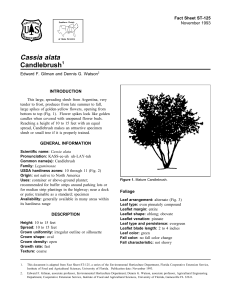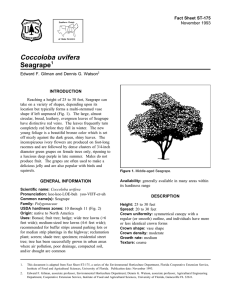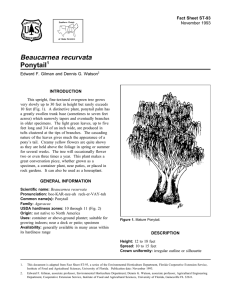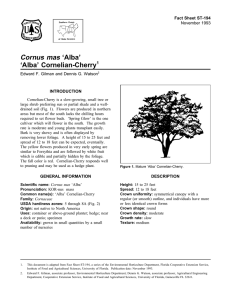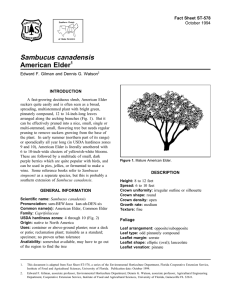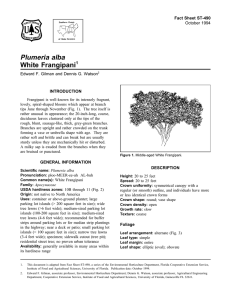Clerodendron trichotomum Harlequin Glorybower Fact Sheet ST-171 1
advertisement
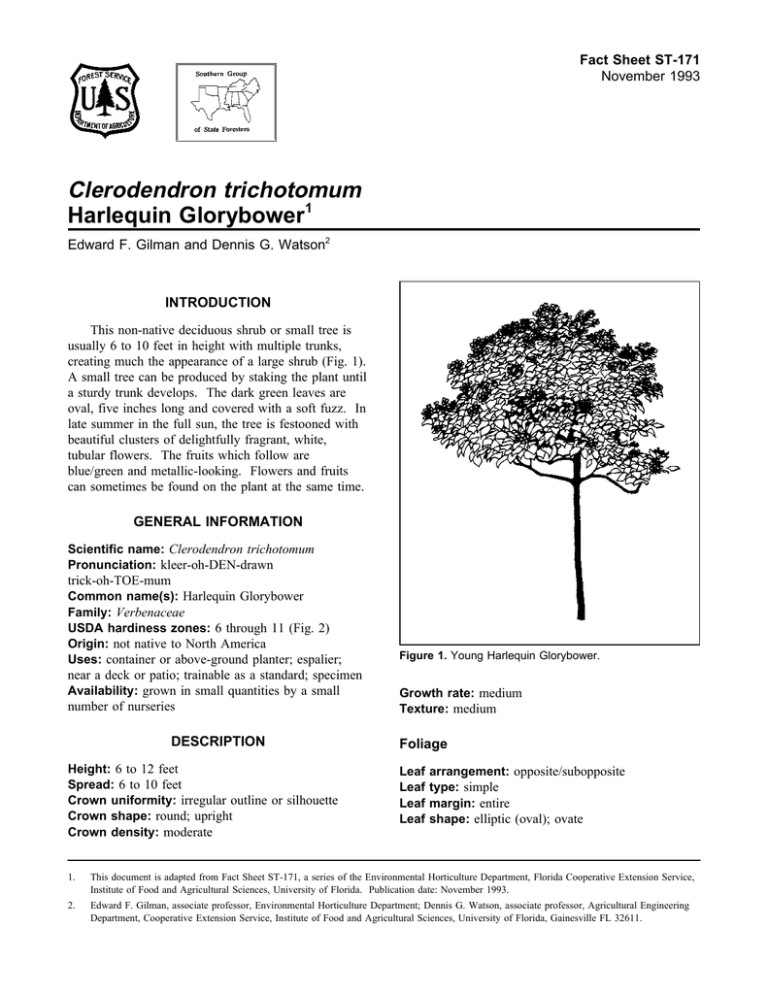
Fact Sheet ST-171 November 1993 Clerodendron trichotomum Harlequin Glorybower1 Edward F. Gilman and Dennis G. Watson2 INTRODUCTION This non-native deciduous shrub or small tree is usually 6 to 10 feet in height with multiple trunks, creating much the appearance of a large shrub (Fig. 1). A small tree can be produced by staking the plant until a sturdy trunk develops. The dark green leaves are oval, five inches long and covered with a soft fuzz. In late summer in the full sun, the tree is festooned with beautiful clusters of delightfully fragrant, white, tubular flowers. The fruits which follow are blue/green and metallic-looking. Flowers and fruits can sometimes be found on the plant at the same time. GENERAL INFORMATION Scientific name: Clerodendron trichotomum Pronunciation: kleer-oh-DEN-drawn trick-oh-TOE-mum Common name(s): Harlequin Glorybower Family: Verbenaceae USDA hardiness zones: 6 through 11 (Fig. 2) Origin: not native to North America Uses: container or above-ground planter; espalier; Figure 1. Young Harlequin Glorybower. near a deck or patio; trainable as a standard; specimen Availability: grown in small quantities by a small number of nurseries Growth rate: medium Texture: medium DESCRIPTION Height: 6 to 12 feet Spread: 6 to 10 feet Crown uniformity: irregular outline or silhouette Crown shape: round; upright Crown density: moderate Foliage Leaf Leaf Leaf Leaf arrangement: opposite/subopposite type: simple margin: entire shape: elliptic (oval); ovate 1. This document is adapted from Fact Sheet ST-171, a series of the Environmental Horticulture Department, Florida Cooperative Extension Service, Institute of Food and Agricultural Sciences, University of Florida. Publication date: November 1993. 2. Edward F. Gilman, associate professor, Environmental Horticulture Department; Dennis G. Watson, associate professor, Agricultural Engineering Department, Cooperative Extension Service, Institute of Food and Agricultural Sciences, University of Florida, Gainesville FL 32611. Clerodendron trichotomum -- Harlequin Glorybower Page 2 Figure 2. Shaded area represents potential planting range. Leaf venation: pinnate Leaf type and persistence: deciduous Leaf blade length: 8 to 12 inches; 4 to 8 inches Leaf color: green Fall color: no fall color change Fall characteristic: not showy Flower Flower color: red Flower characteristics: showy; summer flowering Fruit Fruit Fruit Fruit Fruit Fruit shape: round length: < .5 inch covering: fleshy color: blue characteristics: does not attract wildlife; inconspicuous and not showy; no significant litter problem Trunk and Branches Trunk/bark/branches: droop as the tree grows, and will require pruning for vehicular or pedestrian clearance beneath the canopy; routinely grown with, or trainable to be grown with, multiple trunks; not particularly showy; tree wants to grow with several trunks but can be trained to grow with a single trunk; no thorns Pruning requirement: requires pruning to develop strong structure Breakage: resistant Current year twig color: green; reddish Current year twig thickness: stout Culture Light requirement: tree grows in full sun Soil tolerances: clay; loam; sand; acidic; well-drained Drought tolerance: moderate Clerodendron trichotomum -- Harlequin Glorybower Other Roots: surface roots are usually not a problem Winter interest: no special winter interest Outstanding tree: not particularly outstanding Invasive potential: little, if any, potential at this time Pest resistance: long-term health usually not affected by pests USE AND MANAGEMENT This large shrub or small tree can grow more like a vine if it is not trained and pruned. It can be used near the patio or deck as a flowering ornamental, or placed in a container in a prominent location for display. Not the best looking plant when not in flower, you may want to hide it for 10 months and then ‘bring it out’ when it flowers. Harlequin Glorybower should be grown in full sun or partial shade with sufficient room to allow the plant to spread out. Often the bottom half of the plant appears leggy and should be camouflaged by underplantings. Sprouts and suckers regularly develop at the base of the plant. Page 3

